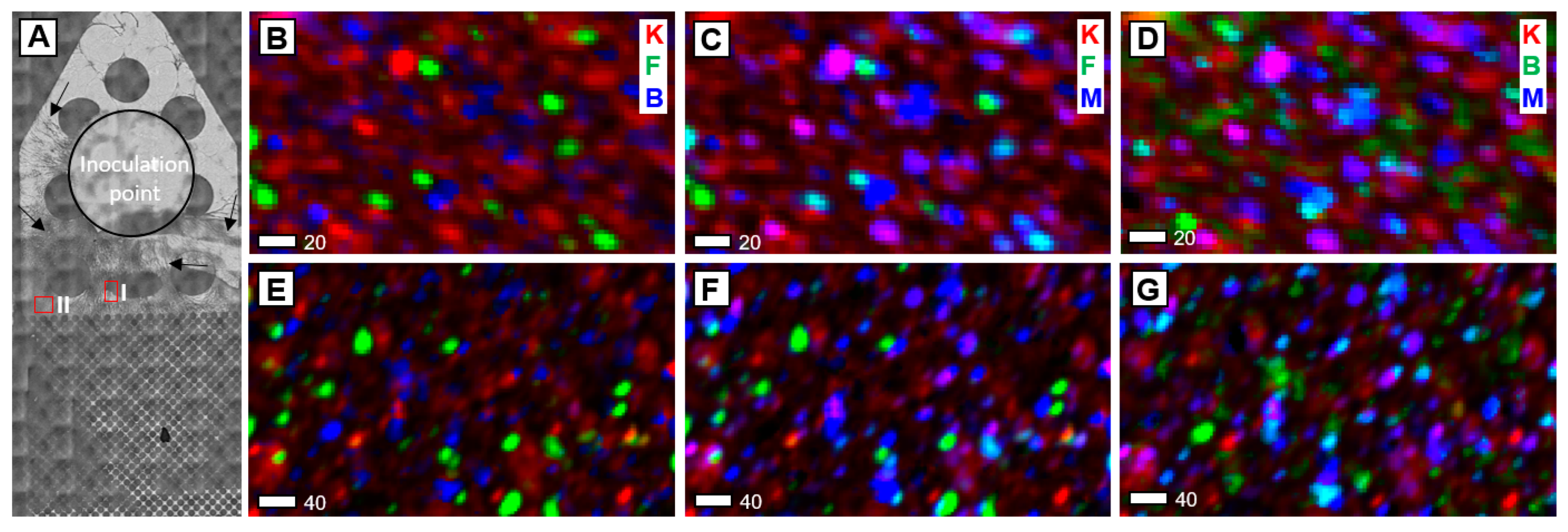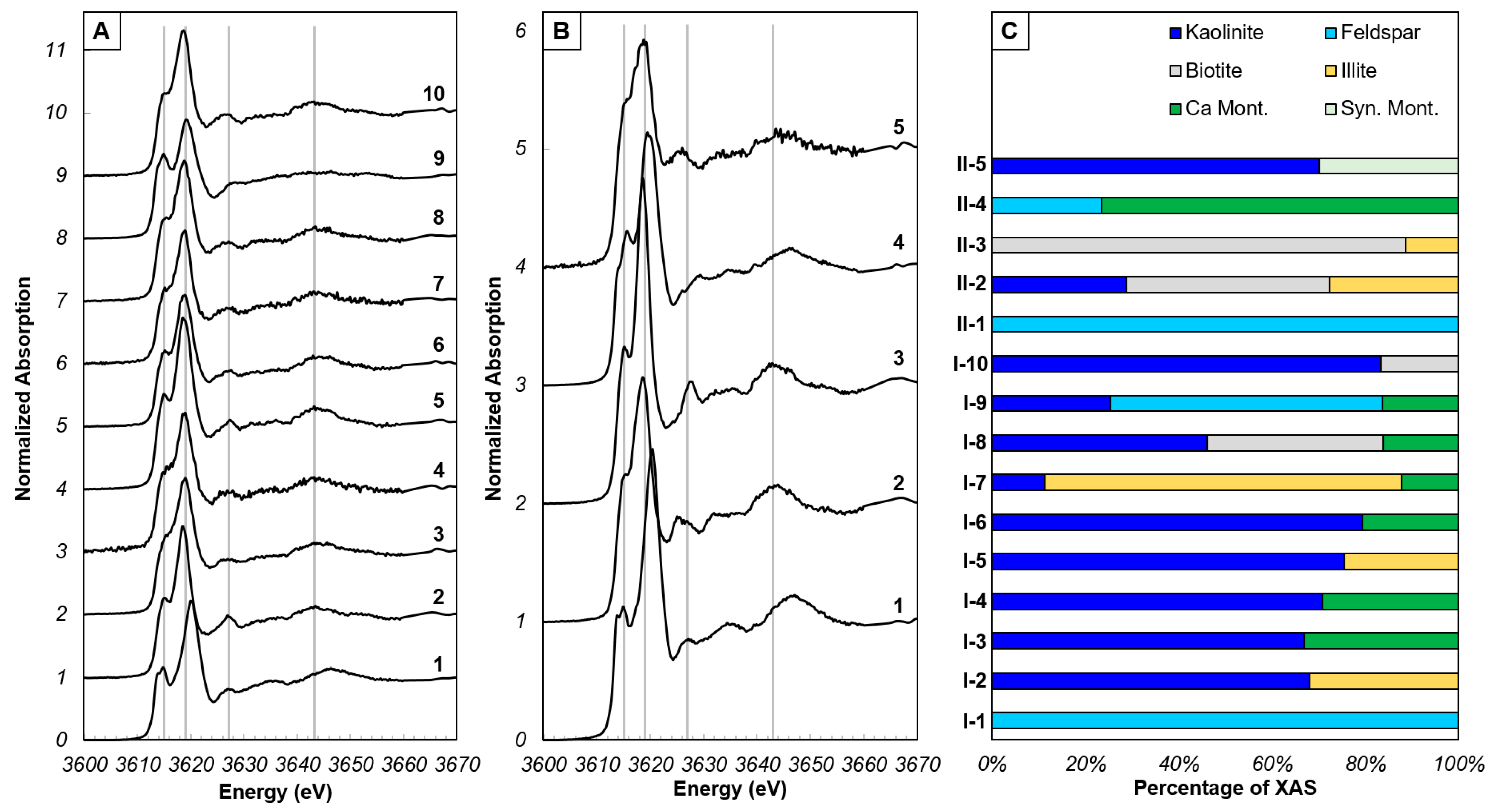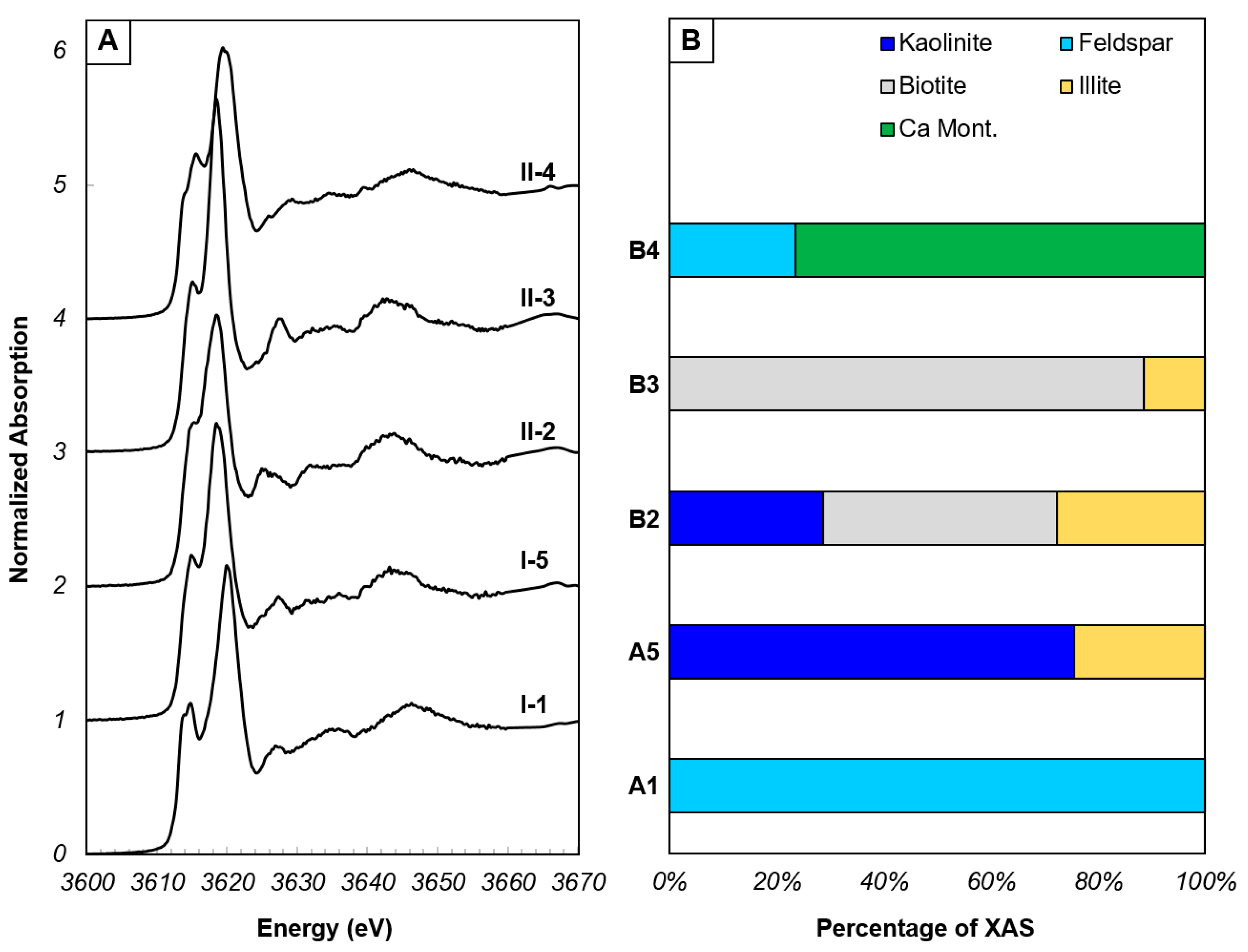Saprotrophic Fungus Induces Microscale Mineral Weathering to Source Potassium in a Carbon-Limited Environment
Abstract
1. Introduction
2. Materials and Methods
2.1. Micromodel Fabrication and Sample Preparation
2.2. Optical Microscopy Imaging of Fungal Hyphae
2.3. XRF Imaging and XANES Spectroscopy
3. Results
4. Discussion
4.1. Potassium XANES Spectroscopy in Environmental Samples
4.2. Impact of Fungal Exudates on Mineral Weathering
4.3. Implications for the Holistic Rhizosphere
5. Conclusions
Supplementary Materials
Author Contributions
Funding
Data Availability Statement
Acknowledgments
Conflicts of Interest
References
- Jones, K.; Nti, F. Impacts and Repercussions of Price Increases on the Global Fertilizer Market. 2022. Available online: https://www.fas.usda.gov/sites/default/files/2022-09/IATR%20Fertlizer%20Final.pdf (accessed on 10 November 2022).
- Vermeulen, S.J.; Campbell, B.M.; Ingram, J.S.I. Climate Change and Food Systems. Annu. Rev. Environ. Resour. 2012, 37, 195–222. [Google Scholar] [CrossRef]
- Britzke, D.; da Silva, L.S.; Moterle, D.F.; dos Santos Rheinheimer, D.; Bortoluzzi, E.C. A Study of Potassium Dynamics and Mineralogy in Soils from Subtropical Brazilian Lowlands. J. Soils Sediments 2012, 12, 185–197. [Google Scholar] [CrossRef]
- Sparks, D.L. Potassium Dynamics in Soils. In Advances in Soil Science; Springer: New York, NY, USA, 1987; pp. 1–63. [Google Scholar]
- Mikkelsen, R.L. Managing Potassium for Organic Crop Production. Horttechnology 2007, 17, 455–460. [Google Scholar] [CrossRef]
- Römheld, V.; Kirkby, E.A. Research on Potassium in Agriculture: Needs and Prospects. Plant. Soil. 2010, 335, 155–180. [Google Scholar] [CrossRef]
- Sattar, A.; Naveed, M.; Ali, M.; Zahir, Z.A.; Nadeem, S.M.; Yaseen, M.; Meena, V.S.; Farooq, M.; Singh, R.; Rahman, M.; et al. Perspectives of Potassium Solubilizing Microbes in Sustainable Food Production System: A Review. Appl. Soil. Ecol. 2019, 133, 146–159. [Google Scholar] [CrossRef]
- Lasaga, A.C. Chemical Kinetics of Water-Rock Interactions. J. Geophys. Res. Solid. Earth 1984, 89, 4009–4025. [Google Scholar] [CrossRef]
- Manning, D.A.C. Innovation in Resourcing Geological Materials as Crop Nutrients. Nat. Resour. Res. 2018, 27, 217–227. [Google Scholar] [CrossRef]
- Li, X.; Yin, Y.; Fan, S.; Xu, X.; Amombo, E.; Xie, Y.; Fu, J. Aspergillus Aculeatus Enhances Potassium Uptake and Photosynthetic Characteristics in Perennial Ryegrass by Increasing Potassium Availability. J. Appl. Microbiol. 2022, 132, 483–494. [Google Scholar] [CrossRef] [PubMed]
- Lian, B.; Wang, B.; Pan, M.; Liu, C.; Teng, H.H. Microbial Release of Potassium from K-Bearing Minerals by Thermophilic Fungus Aspergillus Fumigatus. Geochim. Cosmochim. Acta 2008, 72, 87–98. [Google Scholar] [CrossRef]
- Paris, F.; Bernard, B.; Lapeyrie, F. In Vitro Weathering of Phlogopite by Ectomycorrhizal Fungi II. Effect of K+ and Mg2+ Deficiency and N Sources on Accumulation of Oxalate and H+. Plant. Soil. 1996, 179, 141–150. [Google Scholar] [CrossRef]
- Paris, F.; Bonnaud, P.; Ranger, J.; Lapeyrie, F. In Vitro Weathering of Phlogopite by Ectomycorrhizal Fungi—I. Effect of K+ and Mg2+ Deficiency on Phyllosilicate Evolution. Plant. Soil. 1995, 177, 191–201. [Google Scholar] [CrossRef]
- Pinzari, F.; Cuadros, J.; Jungblut, A.D.; Najorka, J.; Humphreys-Williams, E. Fungal Strategies of Potassium Extraction from Silicates of Different Resistance as Manifested in Differential Weathering and Gene Expression. Geochim. Cosmochim. Acta 2022, 316, 168–200. [Google Scholar] [CrossRef]
- Sheng, X.F. Growth Promotion and Increased Potassium Uptake of Cotton and Rape by a Potassium Releasing Strain of Bacillus Edaphicus. Soil. Biol. Biochem. 2005, 37, 1918–1922. [Google Scholar] [CrossRef]
- Wallander, H.; Wickman, T. Biotite and Microcline as Potassium Sources in Ectomycorrhizal and Non-Mycorrhizal Pinus Sylvestris Seedlings. Mycorrhiza 1999, 9, 25–32. [Google Scholar] [CrossRef]
- Hu, X.; Chen, J.; Guo, J. Two Phosphate- and Potassium-Solubilizing Bacteria Isolated from Tianmu Mountain, Zhejiang, China. World J. Microbiol. Biotechnol. 2006, 22, 983–990. [Google Scholar] [CrossRef]
- Finlay, R.D.; Mahmood, S.; Rosenstock, N.; Bolou-Bi, E.B.; Köhler, S.J.; Fahad, Z.; Rosling, A.; Wallander, H.; Belyazid, S.; Bishop, K.; et al. Reviews and Syntheses: Biological Weathering and Its Consequences at Different Spatial Levels—From Nanoscale to Global Scale. Biogeosciences 2020, 17, 1507–1533. [Google Scholar] [CrossRef]
- Shirale, A.O.; Meena, B.P.; Gurav, P.P.; Srivastava, S.; Biswas, A.K.; Thakur, J.K.; Somasundaram, J.; Patra, A.K.; Rao, A.S. Prospects and Challenges in Utilization of Indigenous Rocks and Minerals as Source of Potassium in Farming. J. Plant. Nutr. 2019, 42, 2682–2701. [Google Scholar] [CrossRef]
- Wild, B.; Daval, D.; Beaulieu, E.; Pierret, M.-C.; Viville, D.; Imfeld, G. In-Situ Dissolution Rates of Silicate Minerals and Associated Bacterial Communities in the Critical Zone (Strengbach Catchment, France). Geochim. Cosmochim. Acta 2019, 249, 95–120. [Google Scholar] [CrossRef]
- Song, M.; Pedruzzi, I.; Peng, Y.; Li, P.; Liu, J.; Yu, J. K-Extraction from Muscovite by the Isolated Fungi. Geomicrobiol. J. 2015, 32, 771–779. [Google Scholar] [CrossRef]
- Lybrand, R.A.; Austin, J.C.; Fedenko, J.; Gallery, R.E.; Rooney, E.; Schroeder, P.A.; Zaharescu, D.G.; Qafoku, O. A Coupled Microscopy Approach to Assess the Nano-Landscape of Weathering. Sci. Rep. 2019, 9, 5377. [Google Scholar] [CrossRef]
- Bhattacharjee, A.; Qafoku, O.; Richardson, J.A.; Anderson, L.N.; Schwarz, K.; Bramer, L.M.; Lomas, G.X.; Orton, D.J.; Zhu, Z.; Engelhard, M.H.; et al. A Mineral-Doped Micromodel Platform Demonstrates Fungal Bridging of Carbon Hot Spots and Hyphal Transport of Mineral-Derived Nutrients. mSystems 2022, 7, e0091322. [Google Scholar] [CrossRef] [PubMed]
- Bhattacharjee, A.; Velickovic, D.; Richardson, J.A.; Couvillion, S.P.; Vandergrift, G.W.; Qafoku, O.; Taylor, M.J.; Jansson, J.K.; Hofmockel, K.S.; Anderton, C.R. Fungal Organic Acid Uptake of Mineral Derived K Is Dependent on Distance from Carbon Hotspot. bioRxiv 2023. [Google Scholar] [CrossRef]
- Bhattacharjee, A.; Anderson, L.N.; Alfaro, T.; Porras-Alfaro, A.; Jumpponen, A.; Hofmockel, K.S.; Jansson, J.K.; Anderton, C.R.; Nelson, W.C. Draft Genome Sequence of Fusarium Sp. Strain DS 682, a Novel Fungal Isolate from the Grass Rhizosphere. Microbiol. Resour. Announc. 2021, 10, 1. [Google Scholar] [CrossRef] [PubMed]
- Cibin, G.; Mottana, A.; Marcelli, A.; Brigatti, M.F. Potassium Coordination in Trioctahedral Micas Investigated by K-Edge XANES Spectroscopy. Miner. Pet. 2005, 85, 67–87. [Google Scholar] [CrossRef]
- Webb, S.M. SIXPack a Graphical User Interface for XAS Analysis Using IFEFFIT. Phys. Scr. 2005, 2005, 1011. [Google Scholar] [CrossRef]
- Ravel, B.; Newville, M. ATHENA, ARTEMIS, HEPHAESTUS: Data Analysis for X-Ray Absorption Spectroscopy Using IFEFFIT. J. Synchrotron Radiat. 2005, 12, 537–541. [Google Scholar] [CrossRef] [PubMed]
- Webb, S.M. SMAK: Sam’s Microprobe Analysis Kit, V 0.46; Stanford Synchrotron Radiation Laboratory: Stanford, CA, USA, 2006. [Google Scholar]
- Schmidt, E.J.; Zanoni, G.; Bumguardner, A.; Šegvić, B.; Lewis, K.; Abdala, D.; Siebecker, M.G. Soil Chemical Extractions Can Alter Potassium Coordination in Agricultural Soils: A Combined Wet Chemical and X-ray Absorption Spectroscopic Approach. Geoderma 2022, 422, 115914. [Google Scholar] [CrossRef]
- Marcus, M.A. X-Ray Photon-in/Photon-out Methods for Chemical Imaging. TrAC-Trends Anal. Chem. 2010, 29, 508–517. [Google Scholar] [CrossRef]
- Li, W.; Liu, X.M.; Hu, Y. Potassium and Calcium K-Edge XANES in Chemical Compounds and Minerals: Implications for Geological Phase Identification. Geostand. Geoanal Res. 2020, 44, 805–819. [Google Scholar] [CrossRef]
- Brigatti, M.F.; Malferrari, D.; Poppi, M.; Mottana, A.; Cibin, G.; Marcelli, A.; Cinque, G. Interlayer Potassium and Its Neighboring Atoms in Micas: Crystal-Chemical Modeling and XANES Spectroscopy. Am. Mineral. 2008, 93, 821–830. [Google Scholar] [CrossRef]
- Xu, W.; Chen, D.; Chu, W.; Wu, Z.; Marcelli, A.; Mottana, A.; Soldatov, A.; Brigatti, M.F. Quantitative Local Structure Determination in Mica Crystals: Ab Initio Simulations of Polarization XANES at the Potassium K-Edge. J. Synchrotron. Radiat. 2011, 18, 418–426. [Google Scholar] [CrossRef] [PubMed]
- Cibin, G.; Mottana, A.; Marcelli, A.; Brigatti, M.F. Angular Dependence of Potassium K-Edge XANES Spectra of Trioctahedral Micas: Significance for the Determination of the Local Structure and Electronic Behavior of the Interlayer Site. Am. Mineral. 2006, 91, 1150–1162. [Google Scholar] [CrossRef]
- Ragoen, C.; Cormier, L.; Bidegaray, A.-I.; Vives, S.; Henneman, F.; Trcera, N.; Godet, S. A XANES Investigation of the Network-Modifier Cations Environment before and after the Na+/K+ Ion-Exchange in Silicate Glasses. J. Non Cryst. Solids 2018, 479, 97–104. [Google Scholar] [CrossRef]
- Jackson, W.E.; Brown, G.E.; Ponader, C.W. X-ray Absorption Study of the Potassium Coordination Environment in Glasses from the NaAlSi3O8-KAlSi3O8 Binary. J. Non Cryst. Solids 1987, 93, 311–322. [Google Scholar] [CrossRef]
- Davies, C.J.; Mayer, A.; Gabb, J.; Walls, J.M.; Degirmenci, V.; Thompson, P.B.J.; Cibin, G.; Golunski, S.; Kondrat, S.A. Operando Potassium K-Edge X-ray Absorption Spectroscopy: Investigating Potassium Catalysts during Soot Oxidation. Phys. Chem. Chem. Phys. 2020, 22, 18976–18988. [Google Scholar] [CrossRef] [PubMed]
- Jacobs, G.; Pendyala, V.R.R.; Martinelli, M.; Shafer, W.D.; Gnanamani, M.K.; Khalid, S.; MacLennan, A.; Hu, Y.; Davis, B.H. Fischer–Tropsch Synthesis: XANES Spectra of Potassium in Promoted Precipitated Iron Catalysts as a Function of Time On-Stream. Catal. Lett. 2017, 147, 1861–1870. [Google Scholar] [CrossRef]
- Li, W.; Liu, X.M.; Hu, Y.; Teng, F.Z.; Hu, Y.F.; Chadwick, O.A. Potassium Isotopic Fractionation in a Humid and an Arid Soil–Plant System in Hawai‘i. Geoderma 2021, 400, 115219. [Google Scholar] [CrossRef]
- Xu, F.; Huang, Z.; Hu, P.; Chen, Y.; Zheng, L.; Gao, J.; Tang, X. The Promotion Effect of Isolated Potassium Atoms with Hybridized Orbitals in Catalytic Oxidation. Chem. Commun. 2015, 51, 9888–9891. [Google Scholar] [CrossRef]
- Dutta, C.M.; Huang, H.W. K-Edge Absorption Spectra of Ionic Potassium and Its Z+1 Analogy. Phys. Rev. Lett. 1980, 44, 643–646. [Google Scholar] [CrossRef]
- Sugiura, C.; Muramatsu, S. K-Edge X-ray Absorption Spectra from Potassium Compounds. Phys. Status Solidi B 1985, 132, K111–K115. [Google Scholar] [CrossRef]
- Spiro, C.L.; Wong, J.; Lytle, F.W.; Greegor, R.B.; Maylotte, D.H.; Lamson, S.H. Forms of Potassium in Coal and Its Combustion Products. Fuel 1986, 65, 327–336. [Google Scholar] [CrossRef]
- Skorina, T.; Allanore, A. Aqueous Alteration of Potassium-Bearing Aluminosilicate Minerals: From Mechanism to Processing. Green. Chem. 2015, 17, 2123–2136. [Google Scholar] [CrossRef]
- Yuan, G.; Cao, Y.; Schulz, H.-M.; Hao, F.; Gluyas, J.; Liu, K.; Yang, T.; Wang, Y.; Xi, K.; Li, F. A Review of Feldspar Alteration and Its Geological Significance in Sedimentary Basins: From Shallow Aquifers to Deep Hydrocarbon Reservoirs. Earth Sci. Rev. 2019, 191, 114–140. [Google Scholar] [CrossRef]
- Wilson, M.J. Weathering of the Primary Rock-Forming Minerals: Processes, Products and Rates. Clay Min. 2004, 39, 233–266. [Google Scholar] [CrossRef]
- Hoffland, E.; Kuyper, T.W.; Wallander, H.; Plassard, C.; Gorbushina, A.A.; Haselwandter, K.; Holmström, S.; Landeweert, R.; Lundström, U.S.; Rosling, A.; et al. The Role of Fungi in Weathering. Available online: https://esajournals.onlinelibrary.wiley.com/doi/epdf/10.1890/1540-9295%282004%29002%5B0258%3ATROFIW%5D2.0.CO%3B2?saml_referrer (accessed on 26 May 2022).
- Drever, J.I.; Vance, G.F. Role of Soil Organic Acids in Mineral Weathering Processes. In Organic Acids in Geological Processes; Springer: Berlin/Heidelberg, Germany, 1994; pp. 138–161. [Google Scholar]
- Smits, M.M. Scale Matters? Exploring the Effect of Scale on Fungal–Mineral Interactions. Fungal Biol. Rev. 2009, 23, 132–137. [Google Scholar] [CrossRef]
- Dörsam, S.; Fesseler, J.; Gorte, O.; Hahn, T.; Zibek, S.; Syldatk, C.; Ochsenreither, K. Sustainable Carbon Sources for Microbial Organic Acid Production with Filamentous Fungi. Biotechnol. Biofuels 2017, 10, 242. [Google Scholar] [CrossRef] [PubMed]
- Li, Z.; Lu, X.; Teng, H.H.; Chen, Y.; Zhao, L.; Ji, J.; Chen, J.; Liu, L. Specificity of Low Molecular Weight Organic Acids on the Release of Elements from Lizardite during Fungal Weathering. Geochim. Cosmochim. Acta 2019, 256, 20–34. [Google Scholar] [CrossRef]
- Stillings, L.L.; Drever, J.I.; Brantley, S.L.; Sun, Y.; Oxburgh, R. Rates of Feldspar Dissolution at PH 3–7 with 0–8 m M Oxalic Acid. Chem. Geol. 1996, 132, 79–89. [Google Scholar] [CrossRef]
- Schmalenberger, A.; Duran, A.L.; Bray, A.W.; Bridge, J.; Bonneville, S.; Benning, L.G.; Romero-Gonzalez, M.E.; Leake, J.R.; Banwart, S.A. Oxalate Secretion by Ectomycorrhizal Paxillus Involutus Is Mineral-Specific and Controls Calcium Weathering from Minerals. Sci. Rep. 2015, 5, 12187. [Google Scholar] [CrossRef]
- Huang, W.H.; Keller, W.D. Organic Acids as Agents of Chemical Weathering of Silicate Minerals. Nat. Phys. Sci. 1972, 239, 149–151. [Google Scholar] [CrossRef]
- Manley, E.P.; Evans, L.J. Dissolution of Feldspars by Low-Molecular-Weight Aliphatic and Aromatic Acids. Soil. Sci. 1986, 141, 106–112. [Google Scholar] [CrossRef]
- Wang, X.; Li, Q.; Hu, H.; Zhang, T.; Zhou, Y. Dissolution of Kaolinite Induced by Citric, Oxalic, and Malic Acids. J. Colloid. Interface Sci. 2005, 290, 481–488. [Google Scholar] [CrossRef] [PubMed]
- Welch, S.A.; Ullman, W.J. The Effect of Organic Acids on Plagioclase Dissolution Rates and Stoichiometry. Geochim. Cosmochim. Acta 1993, 57, 2725–2736. [Google Scholar] [CrossRef]
- Eggleton, R.A.; Buseck, P.R. High Resolution Electron Microscopy of Feldspar Weathering. Clays Clay Min. 1980, 28, 173–178. [Google Scholar] [CrossRef]
- Zúñiga-Silgado, D.; Rivera-Leyva, J.C.; Coleman, J.J.; Sánchez-Reyez, A.; Valencia-Díaz, S.; Serrano, M.; De-Bashan, L.E.; Folch-Mallol, J.L. Soil Type Affects Organic Acid Production and Phosphorus Solubilization Efficiency Mediated by Several Native Fungal Strains from Mexico. Microorganisms 2020, 8, 1337. [Google Scholar] [CrossRef] [PubMed]
- He, Y.; Ma, L.; Li, X.; Wang, H.; Liang, X.; Zhu, J.; He, H. Mobilization and Fractionation of Rare Earth Elements during Experimental Bio-Weathering of Granites. Geochim. Cosmochim. Acta 2023, 343, 384–395. [Google Scholar] [CrossRef]
- Islam, M.K.; Sano, A.; Majumder, M.S.I.; Sakagami, J.I.; Gima, S.; Hossain, M.A. Evaluation of Organic Acid Production Potential of Phosphate Solubilizing Fungi Isolated from Soils in Okinawa, Japan. Appl. Ecol. Environ. Res. 2019, 17, 15191–15201. [Google Scholar] [CrossRef]
- Gadd, G.M. Fungal Production of Citric and Oxalic Acid: Importance in Metal Speciation, Physiology and Biogeochemical Processes. Adv. Microb. Physiol. 1999, 41, 47–92. [Google Scholar] [CrossRef]
- Van Schöll, L.; Smits, M.M.; Hoffland, E. Ectomycorrhizal Weathering of the Soil Minerals Muscovite and Hornblende. New. Phytol. 2006, 171, 805–814. [Google Scholar] [CrossRef]
- Perner, H.; Schwarz, D.; Bruns, C.; Mäder, P.; George, E. Effect of Arbuscular Mycorrhizal Colonization and Two Levels of Compost Supply on Nutrient Uptake and Flowering of Pelargonium Plants. Mycorrhiza 2007, 17, 469–474. [Google Scholar] [CrossRef]
- Garcia, K.; Zimmermann, S.D. The Role of Mycorrhizal Associations in Plant Potassium Nutrition. Front. Plant. Sci. 2014, 5, 337. [Google Scholar] [CrossRef] [PubMed]
- Fellbaum, C.R.; Gachomo, E.W.; Beesetty, Y.; Choudhari, S.; Strahan, G.D.; Pfeffer, P.E.; Kiers, E.T.; Bücking, H. Carbon Availability Triggers Fungal Nitrogen Uptake and Transport in Arbuscular Mycorrhizal Symbiosis. Proc. Natl. Acad. Sci. USA 2012, 109, 2666–2671. [Google Scholar] [CrossRef] [PubMed]
- Peng, L.; Shan, X.; Yang, Y.; Wang, Y.; Druzhinina, I.S.; Pan, X.; Jin, W.; He, X.; Wang, X.; Zhang, X.; et al. Facultative Symbiosis with a Saprotrophic Soil Fungus Promotes Potassium Uptake in American Sweetgum Trees. Plant. Cell. Environ. 2021, 44, 2793–2809. [Google Scholar] [CrossRef] [PubMed]
- Sheng, X.F.; He, L.Y. Solubilization of Potassium-Bearing Minerals by a Wild-Type Strain of Bacillus Edaphicus and Its Mutants and Increased Potassium Uptake by Wheat. Can. J. Microbiol. 2006, 52, 66–72. [Google Scholar] [CrossRef] [PubMed]
- Zhang, C.; Kong, F. Isolation and Identification of Potassium-Solubilizing Bacteria from Tobacco Rhizospheric Soil and Their Effect on Tobacco Plants. Appl. Soil. Ecol. 2014, 82, 18–25. [Google Scholar] [CrossRef]
- Basak, B.B.; Biswas, D.R. Co-Inoculation of Potassium Solubilizing and Nitrogen Fixing Bacteria on Solubilization of Waste Mica and Their Effect on Growth Promotion and Nutrient Acquisition by a Forage Crop. Biol. Fertil. Soils 2010, 46, 641–648. [Google Scholar] [CrossRef]
- Angst, G.; Mueller, K.E.; Nierop, K.G.J.; Simpson, M.J. Plant- or Microbial-Derived? A Review on the Molecular Composition of Stabilized Soil Organic Matter. Soil. Biol. Biochem. 2021, 156, 108189. [Google Scholar] [CrossRef]
- Churchman, G.J.; Singh, M.; Schapel, A.; Sarkar, B.; Bolan, N. Clay Minerals As the Key To the Sequestration of Carbon in Soils. Clays Clay Min. 2020, 68, 135–143. [Google Scholar] [CrossRef]
- Han, L.; Yang, Y.; Sun, K.; Zhang, B.; Chen, Y.; Fang, L.; Xing, B. Different Mechanisms Driving the Preferential Adsorption of Dissolved Organic Matter by Goethite and Montmorillonite. Chem. Geol. 2021, 585, 120560. [Google Scholar] [CrossRef]



Disclaimer/Publisher’s Note: The statements, opinions and data contained in all publications are solely those of the individual author(s) and contributor(s) and not of MDPI and/or the editor(s). MDPI and/or the editor(s) disclaim responsibility for any injury to people or property resulting from any ideas, methods, instructions or products referred to in the content. |
© 2023 by the authors. Licensee MDPI, Basel, Switzerland. This article is an open access article distributed under the terms and conditions of the Creative Commons Attribution (CC BY) license (https://creativecommons.org/licenses/by/4.0/).
Share and Cite
Richardson, J.A.; Anderton, C.R.; Bhattacharjee, A. Saprotrophic Fungus Induces Microscale Mineral Weathering to Source Potassium in a Carbon-Limited Environment. Minerals 2023, 13, 641. https://doi.org/10.3390/min13050641
Richardson JA, Anderton CR, Bhattacharjee A. Saprotrophic Fungus Induces Microscale Mineral Weathering to Source Potassium in a Carbon-Limited Environment. Minerals. 2023; 13(5):641. https://doi.org/10.3390/min13050641
Chicago/Turabian StyleRichardson, Jocelyn A., Christopher R. Anderton, and Arunima Bhattacharjee. 2023. "Saprotrophic Fungus Induces Microscale Mineral Weathering to Source Potassium in a Carbon-Limited Environment" Minerals 13, no. 5: 641. https://doi.org/10.3390/min13050641
APA StyleRichardson, J. A., Anderton, C. R., & Bhattacharjee, A. (2023). Saprotrophic Fungus Induces Microscale Mineral Weathering to Source Potassium in a Carbon-Limited Environment. Minerals, 13(5), 641. https://doi.org/10.3390/min13050641




